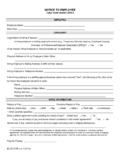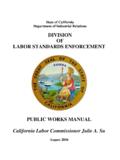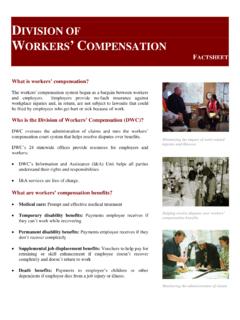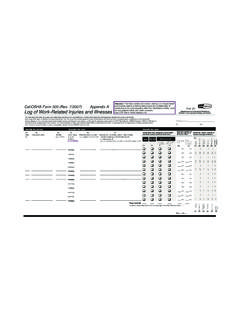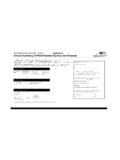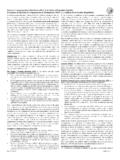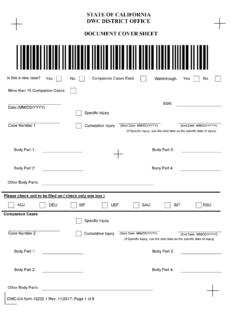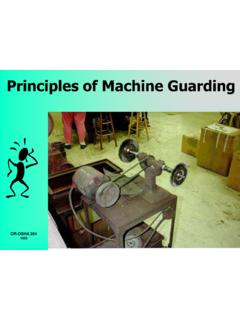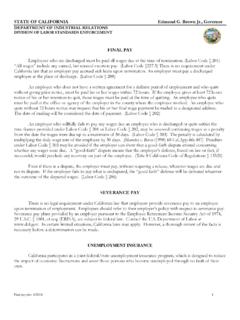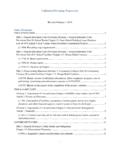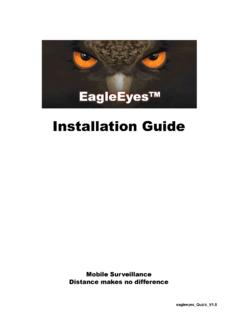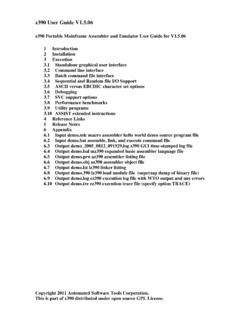Transcription of Guide for Supported Scaffolds - California …
1 Commonly Used Supported Scaffolds Selected Cal/OSHA Regulations Guide FOR WORKING SAFELY WITH Supported Scaffolds Scaffolding provides safety and adds to Frame or Fabricated Tube and Coupler Outrigger scaffold Bracket scaffold Tower/Rolling Horse scaffold Ladder Jack System Scaffolds (See Title 8 CA Code of Regulations for all regulations) The company s Code of Safe Practice (COSP) must include safety requirements for erection, use, and dismantling of Scaffolds . the efficiency of work. However, unsafe scaffolding can lead to accidents, serious injuries and death. This Guide promotes awareness of safe work practices for Supported Scaffolds and covers: Types of Commonly Used Supported Scaffolds Common Scaffolding Hazards Selected CAL/OSHA Regulations Safe Work Practices Safety Tip Following manufacturer s instructions, complying with Cal/OSHA regulations, and using this Guide as a reference help you in working safely with Supported Scaffolds .
2 For help from Cal/OSHA call 1-800-963-9424 or visit Common Scaffolding Hazards Individuals exposed to scaffolding hazards include scaffold erectors and dismantlers, personnel working on/under Scaffolds , and employees and the general public near scaffolding. scaffold erectors and dismantlers are at particular risk, since they work on Scaffolds before ladders, guardrails, platforms, and planks are completely installed. Common scaffolding hazards are: Hazards From Structural Flaws Missing/improperly Supported base plates scaffold not tied properly to building platform slope exceeds requirement Legs not pl umb Braces/runners/cross-bracing not secure Missing braces/runners and cross-bracing Some planks overextended/under extended Severe overloading/danger of collapse Broken pins on frames Fall Hazards Missing mid and top guardrails Improper access Platforms not fully planked Substandard planks Falling objects/missing toe boards Slippery platforms Electrical Hazards Building scaffold too close to power lines
3 Ungrounded/damaged tools & equipment on scaffold These hazards mainly come from parts failure, not following proper installation, inspection, and dismantling procedures, the failures at attachment points, inadequate fall protection, changing weather conditions, and overloading of Scaffolds . Beware of falls and scaffold collapse. The company s Injury & Illness Prevention Program (IIPP) m ust provide information on inspection of Scaffolds , correction of hazards found, and training for scaffold erectors, users and dismantlers. The design and construction of Scaffolds must conform to standards and requirements of 1637.
4 Each scaffold must be designed to support its own weight and 4 times the maximum load. See 1637(b) for maximum working loads. scaffold erection and dismantlement must be supervised by a qualified person. scaffold must be erected and dismantled according to design standards, engineered specifications, or manufacturer s instructions. 1637 A Cal/OSHA permit is required for erecting and dismantling Scaffolds that exceed three stories or 36 ft. in height. 341(d)(5)(B) A safe and unobstructed means of access, such as a walkway, stair, or ladder shall be provided to all scaffold platforms. 1637(n)(1) Anchorage and bracing shall be such that Scaffolds and falsework will be prevented from swaying, tipping, or collapsing.
5 1637(c) Manufactured planks shall be able to support its weight plus 4 times the live load. 1637(f)(3)(A) Workers on Scaffolds who are exposed to overhead hazards shall be provided with overhead protection or other means that will effectively eliminate the hazard. 1637(q) platform must be at least 20 wide and shall not be sloped more than 2 to 10. Slippery platform conditions are prohibited. 1637(p) Selected regulations continued in next November 2012 Cal/OSHA publications are available at Guardrails must be installed on open sides and ends of platforms that are 7 1/2 ft. or higher. 1621(a) Toeboards are required on all railed sides of work surfaces where employees work or pass below.
6 1621(b) Follow height limits (see exceptions): 1643, 1644 Wood (fr ame/post): 60 ft. Tube & coupler/ Tubular ( welded): 125 ft. No work shall be done on or from Scaffolds during storms or high winds (see exceptions). 1637(u) In addition, specific types of Supported Scaffolds have their own set of Cal/OSHA requirements. Below is a partial list: Metal Scaffolds 1644 Tower and rolling Scaffolds 1646 Ladder jack Scaffolds 1648 Outrigger and bracket Scaffolds 1645 Horse Scaffolds 1647 Window jack Scaffolds 1654 Safety Tips for Working Safely with Scaffolds Select the right type for the job.
7 Design and construct to standards. Follow manufacturer s guidelines for proper erection, use and dismantling. Inspect daily and before each use. Maintain stability at all times. Don t climb using railings. Use the provided access. Don t take short cuts. Do not overload the scaffold . Cover scaffold safety in the COSP and train all involved in erection, use, and dismantling. Safe Work Practices Scaffolding accidents can occur during erection, use and dismantling of Scaffolds . The following Safe Work Practices can help in preventing scaffold related accidents. Do these during scaffold design and selection: Select proper scaffold /scaffolding material.
8 Follow proper design for constructed scaffold . Follow all requirements from manufacturer. Follow all Title 8 design requirements. Have the stationary Scaffolds over 125 feet in height and rolling Scaffolds over 60 feet in height designed by a professional engineer. Follow these during erection and dismantling: scaffold and each level are maintained plumb. scaffold is being erected under the direction of a qualified person. All employees involved with (or near) the scaffold wear hard hats. Footings are sound and rigid. Scaffolds are built from the bottom up and dismantled from the top down.
9 The scaffold is secured to the structure during erection and dismantling. Ties to the structure are installed as soon as the scaffold is completed to each tie-in area. If platforms are sloped, the slope is no more than 2 feet vertical to 10 feet horizontal. Platforms are also secured so they can t slip. When a platform turns a corner, pl anks are laid so as to avoid tipping. Guardrails on open sides/toeboards on all railed sides are provided as required. Proper access is provided. Electrical safety clearance distances are maintained and consideration for long materials such as gutters and pipes is given when determining clearances.
10 scaffold requirements for your trade are followed. Ties are removed only as the work progresses downward, unless other methods are used to prevent the scaffold from falling over. When dismantling, structural members are not removed below the level being dismantled. Do these during scaffold use: Have scaffold inspected by a qualified person before putting in use. Inspect daily and before each use. Quick scaffold Inspection Check for: Missing/damaged planks Missing guardrails/toeboards Proper access Proper tying off to buildings Clearance from electric lines Any overhead obstructions If the scaffold is level and plumb Use Scaffolds as per manufacturer instructions.
